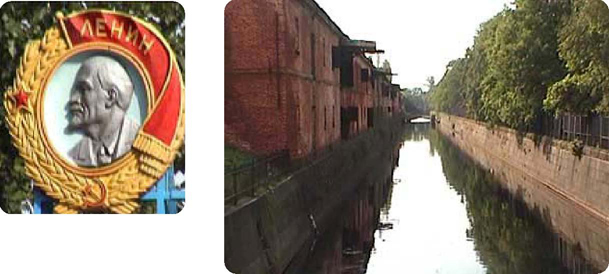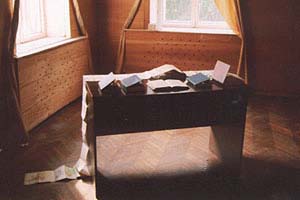
Gillian McIver

In summer of 2003 Gillian McIver, Hilary Powell and Julian Ronnefeldt of Luna Nera went to make a site-responsive project in Russia. The site was the historic naval fortress town of Kronstadt, which is located about 29km north west of St Petersburg on Kotlin island in the Gulf of Finland. Peter the Great created this sea fortress in 1703, seeing it as a vital extension of the capital on the river Neva. Guarding the approach to the city, for 300 years Kronstadt offered protection to the Russian Empire and became a starting point for many great journeys of exploration out of Russia. Celebrated Russian navigators studied and researched here with many inventions made, tested and pioneered in the town. These include Popov’s invention of radio, Butakov’s mechanical telegraph, undersea mines, torpedoes and submarines and pioneering anti plague and water chlorination laboratories. But perhaps Kronstadt is best known due its role in the first and last popular armed uprisings against the rule of the communist party. Kronstadt sailors played major roles in the revolutions of 1905 and 1917 and, in 1921, they revolted once again against what they saw as the betrayal of the revolution by the Bolshevik regime.
Today Kronstadt suffers from the public neglect that has been plaguing Russia since perestroika. The approach to Kronstadt is notable for the long drive past expensive dachas of the rich, high-walled and bristling the CCTV cameras. The great highway along the tidal barrier that was begun in the late 1980s stands unfinished, falling into ruins. Once on the island the naval installations and buildings are crumbling, paint is peeling. But with the 2003 tercentennial of St Petersburg this is beginning to change: the central market (gostiny dvor) is being renovated and new national funds are being granted to restore Kronstadt. It is easy to see how magnificent the town was in its heyday: the anchor motif appears everywhere, richly decorating fences, gates, towers and buildings. The crumbling palaces and the gorgeous cathedral still have the power to impress the visitor. And the town is still full of young naval recruits in their distinctive, timeless costume.
The project was organised by Gillian McIver of Luna Nera, assisted by St Petersburg artist/curator Oleg Yanushevsky, in conjunction with the Centre for Contemporary Art St Petersburg. The NCCA obtained the space and provided the infrastructure, including buses to bring people from the city to the vernissage.
The area available for the exhibition Slovo Khudozhnika/ Word of the Artist was located on the canal in the central area of Kronstadt named the Admiralty. Nearby is the grandiose Naval Cathedral as well as many docks, pools and basins which lead to the harbour. The artists were given two buildings: the Residence, a former official’s house, and a derelict former naval storehouse contiguous to the Residence, which was the main site for the exhibition.
Gillian McIver’s projects for Kronstadt 2003 were presented in both spaces.

[ “A history of the world in six volumes”]
Inside the Residence, the sparse wood panelled rooms housed two related text-based
installations. “Sails” was an installation of texts from old books
(English, Russian and German) on European history and philosophy, focused on
the Enlightenment, Napoleonic and Imperial eras. Deconstructed, the pages formed
hanging sails which wafted in the summer breeze through open windows in the
old house. The now-empty book covers became the second installation, “A
history of the world in six volumes.” The installations created or provoked alternative
readings of the meta-history of the past. The books chosen date from specific
eras and deal with deliberately chosen themes: empire, naval power and nation
building. Today the books - the most recent date from 1949 - can be read as
“propaganda” but this brings up the issue of whether today’s
“truth” may be tomorrow’s “propaganda”. On the
other hand, the materials that replace the pages of some of the volumes - elemental
substances such as bread, salt, wood and earth - are the timeless realities
from which “history” is made.

[ “Bridges of St Petersburg” projection; "Sails" installation]
In “Bridges of St Petersburg,” which was projected on the rough bare wall of the storehouse, she went on to deal with another almost archetypal substance: the body of water that surrounds and creates the city: the rivers Moyka, Fontanka and Neva, and the web of canals. The everpresent consciousness of water is counterpointed by the mechanistic rhythms of the thirteen great bridges on the Neva, which open and close nightly to allow access to the sea. Installed in the storehouse, the film “Bridges of St Petersburg” was an environmental montage loop that mixed classic film footage with present material, fusing past and present representation of key emblems of St Petersburg.
“looking at Russia through the binoculars of the people” The Storehouse

“Looking at Russia through the binoculars of the people” was created at Kronstadt in the Storehouse. The artist took fragments… found wood and metal from the site, and from local tourist markets and junk shops, traditional matrioshki dolls, Soviet posters, an old projector, giant film projector-lenses, record players etc to create a “peep show” shelter within the Storehouse. Playing with the idea of "spying" and "secrets" in this formerly closed town (closed throughout its history until 1996) Ronnefeldt invited the visitors to reverse the process of espionage and turn the visitors, which once were the subjects spied upon, into the spies spying on their own existence and past.
“Touching the theme of espionage in a relatively young Russia was not intended to “raise the finger” and remind the Russians of their difficult past. That would be a presumptuous position for a western person and a hypocritical one too, living in the country which boasts about its total CCTV control —implemented “for our own safety.” Rather , the work is meant to awaken memories and moments in the past of a nation which has undergone radical change in a very short period of time. Such a process tends to eradicate all heritage - the negative and the positive aspects - and with this, the danger of a system overtaking the vacuum that is left and using it to its advantage, but not actually changing anything to the advantage for the people. looking at russia through the binoculars of the people looks at the old, which has turned into a cliché of itself, and can be acquired in souvenir shops on the high street.” - Julian Ronnefeldt

left and centre: installation Navigating History (bottles, video, prints). Right, Submergency, photographs displayed on monitor. The Storehouse.
2004